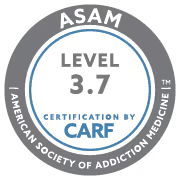Table of Contents
Do you need a drink to soothe your nerves every now and then or to unwind after a long day? Are you in complete control over your habit or is there more to it than you would care to admit?
In societies where a glass of wine or a shot of whiskey is par for the course, it's often easy to overlook the line between casual drinking and potential alcohol dependency.
This article unravels the subtle indicators of a drinking problem and offers essential guidance to anyone who wants to evaluate their drinking habits.
Understanding Alcohol Use and Abuse
So, what does ‘normal’ drinking look like?
For many, it’s a glass of wine at dinner or a beer with friends on Friday night. But when does such apparently innocent behavior slip into alcohol abuse? That’s the question we’ll try to answer.
As defined by the Diagnostic and Statistical of Mental Disorders, Fifth Edition (DSM-5), Alcohol Use Disorder (AUD) is a pattern of drinking that results in distress or harm. That could mean drinking more or longer than intended or continuing to drink despite problems with relationships or health.
Statistically, alcohol issues are not as rare as one might think. According to the National Institute on Alcohol Abuse and Alcoholism (NIAAA), approximately 29.5 million Americans suffer from AUD.
These numbers underscore the thin line between casual drinking and a potential health crisis. They also highlight the importance of recognizing when your or a loved one’s drinking habits may be veering into dangerous territory.
Common Signs of a Drinking Problem
Recognizing the signs of a drinking problem can be difficult, especially when it happens gradually.
On the physical side, you might notice an increased tolerance: that single glass of wine doesn't give you the same buzz it used to. Or it could be that your mornings start with a headache or a need for a drink to steady your nerves.
On the behavioral side, alcohol might begin to dominate your priorities. If you've ever missed an important family event because you were hungover, or if work deadlines slip because of last night's drinking, these are red flags.
A drinking problem is not only about choosing to drink irresponsibly but also about what you're choosing to forgo or not to do in order to have that drink.
The psychological effects of a budding drinking problem can be profound. Mood swings, irritability, or depression that seems to worsen after drinking are all indicators that alcohol is playing a larger role than you might realize.
Let’s imagine a middle-aged man who starts by enjoying a harmless drink or two after work. Over time, both the number of drinks and the duration of time spent drinking begin to rise. Slowly, he begins to choose the bar over family time and social engagements. Eventually, alcohol takes over everything else in life, from personal relationships and financial responsibilities to professional obligations.
The final stage is when the urge to drink has overpowered all regard for personal well-being, mental and physical, and he continues drinking even though he is fully aware that it is destroying his life.
That is the drinking curve from socially acceptable to extreme in a nutshell. It describes an all too common scenario where drinking gradually shifts subtly from an occasional social activity to severe alcohol dependence.
The Impact of Alcohol Abuse on Life and Health
The effects of excessive drinking extend far beyond the next day’s hangover.
In the short term, overindulgence can lead to poor judgment and result in strained relationships or professional missteps, like unmet deadlines or missed meetings.
The long-term consequences are significantly more grave. Chronic alcohol use significantly increases the risk of serious health issues such as liver disease, heart problems, and various cancers.
For instance, consider the Centers for Disease Control and Prevention (CDC) statistics that link excessive alcohol consumption to approximately 178,000 deaths in the US each year. That translates to 488 deaths per day, due to causes ranging from liver cirrhosis to car accidents.
Alcohol misuse is also strongly correlated with mental health issues like depression and anxiety. It can create a vicious cycle of drinking to cope with emotional pain and end up exacerbating the original problem.
Let’s run another scenario to better understand the impact of alcohol abuse on life and health.
Imagine a successful marketing executive who indulges in the occasional drink to relieve stress, unwinding with colleagues after a punishing day at work. Gradually, however, this occasional drinking escalates to more frequent and heavier consumption. The consequences start to manifest subtly at first—missed mornings, delayed projects, and lapses in judgment.
Over time, the effects become severe. The executive experiences health issues such as heart arrhythmias—a direct result of chronic alcohol consumption.
Professionally, his once sharp and reliable performance deteriorates. Meetings are forgotten, deadlines are consistently missed, and erratic behavior begins to raise concerns among colleagues and superiors.
This hypothetical scenario illustrates how alcohol abuse can creep in silently and end up causing serious consequences to an individual's career, health, and overall well-being. It's a stark reminder that what might start as a manageable habit can quickly spiral into a destructive pattern that affects every aspect of life if left unchecked.
Self-Assessment and When to Seek Help
Evaluating your drinking habits requires a healthy dose of honesty and self-awareness.
Tools like the CAGE questionnaire can be a practical starting point for self-assessment. It consists of a simple set of four questions about your need to cut down, annoyance by criticism, guilty feelings, and eye-openers, like drinking first thing in the morning.
Answering ‘yes’ to two or more questions suggests a potential problem!
Denial often masks the severity of the issue. Consider the case of someone who consistently brushes off family concerns about their drinking habits. In such cases, the issue may become impossible to ignore only after a serious incident, such as a DUI, forces a confrontation with reality.
It’s essential to recognize such warning signs early on and consider seeking professional help. After all, acknowledging the problem is the first step toward recovery!
How Hollywood Hills Recovery Can Help
At Hollywood Hills Recovery, we understand that overcoming alcohol addiction calls for a personalized and empathetic approach.
Set in the serene hills of Los Angeles, our center provides a sanctuary for those seeking to break free from the chains of addiction. With a variety of inclusive treatment programs, we ensure that every aspect of recovery is addressed.
From inpatient detox to intensive residential therapy and comprehensive aftercare, our treatments are designed to meet the unique needs of each individual. Our experienced team, many of whom have walked the path to recovery themselves, offers support that is both professional and deeply personal.
We don’t just treat addiction; we empower individuals to rebuild their lives and find lasting sobriety.
Contact Hollywood Hills Recovery today to discover how we can help you achieve recovery that endures!!












